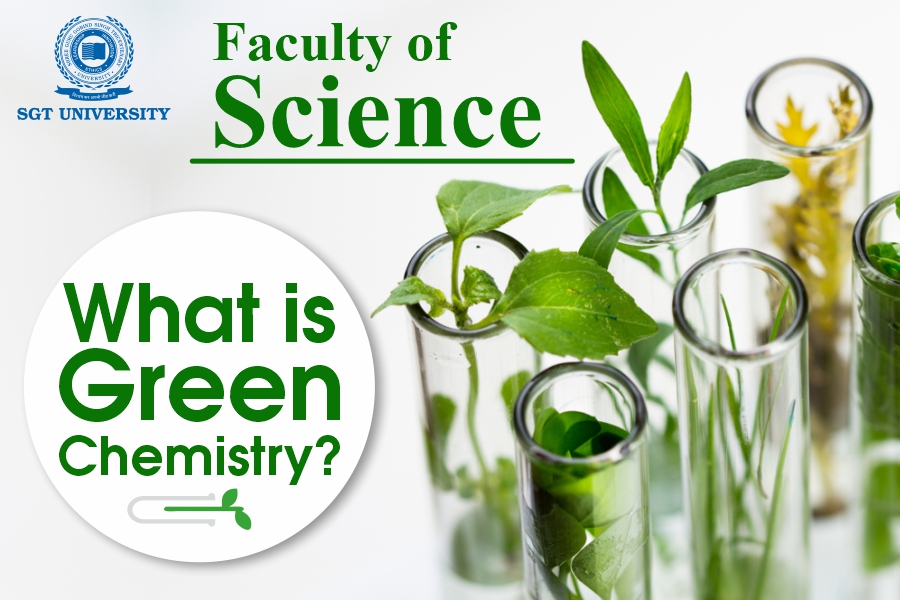The ‘Green Chemistry’ is chemistry with a ‘Green’ purpose. This means the environmentally friendly chemistry is developed and used to reduce environmental footprints, conserve natural resources, and thus keep nature green.
Green Chemistry is the schematic design and use of the chemical products and the methods to eliminate or decrease the use and generation of toxic solid, liquid or gaseous waste. There are twelve principles of green chemistry.
The first principle is to ‘Prevent Waste’. As a Green Chemist, chemical transformations should be designed to minimise hazardous waste generation or minimise toxic chemicals. This will further reduce the hazards related to waste transport, storage, and treatment in waste treatment plants.
The next vital step is to maximise the ‘Atom Economy’, which measures the proportion of reactants that convert to a functional product. As a green technologist, experiments should be designed to convert all starting materials into the product, resulting in fewer waste atoms or by-products. This will be a more efficient and waste minimising step.
The next principle is ‘Designing Less Hazardous Chemical Synthesis’. Wherever feasible, synthetic projects should be designed to generate and utilise the substances or chemicals which possess minor or no hazard to human health and the environment.
Also Read: What is Thermal Imaging – Where is it used?
The goal should be to use environmentally friendly substances that simulate the minimum hazard and produces only fewer side products as waste. However, the materials should be designed to be potentially effective for the target application and inherently minimises toxicity.
In academic labs and industries, the principle ‘Design Safer Chemical and Product’ should be applied in designing the new target products. However, the principle of ‘Safer Solvents and Reaction Conditions’ should be used to achieve this goal, which is very important as the solvent used leads to waste.
Also Read: Physics Behind the Artificial Molecular Machines
The reduction of solvent amount or complete exclusion of solvents should be preferred. In cases where the solvent is required, less toxic solvents should be used to minimise environmental and economic impacts.
Whenever possible, methods should be designed to use ambient temperature and pressure; this would minimise the energy costs and follow the next principle of Green Chemistry, i.e. ‘Increase Energy Efficiency’.
In addition, ‘Use of Catalysts should be encouraged as a Green Chemist. It is well-known that catalysts can reduce the temperature of a reaction, enhance the selectivity of a reaction, and thus improve reactants’ conversion to products.
However, by reducing the reaction temperatures, one can minimise the energy uses, potentially avoid undesirable side reactions, and thus minimise side-product formation.
The next and most important principle is ‘Avoid Derivatives’. This means that unnecessary protection and de-protection of functional groups should be avoided because such steps require additional chemicals and generate waste.
Wherever applicable, ‘Renewable Raw Material should be Utilised’. The targets should be designed so that renewable raw materials such as agricultural products or agricultural wastes can be used as much as possible. This will help deplete feedstocks mined or generated from fossil fuels (e.g. coal, natural gas, petroleum, etc.).
The next vital principle of Green Chemistry is designing for the ‘Degradation’. The efforts related to this principle emphasise designing and synthesising materials that degrade or reduce into nontoxic substances when released into the environment.
This implies that projects or materials should be designed so that they break down into harmless degradation fragments at the end of their function and do not persist in the environment.
The principle ‘Analyse in Real-Time to Prevent Pollution’ should implicate strongly. This principle is actually about monitoring the prevention of pollution during the progress of a reaction or a project to identify the development of any undesirable hazardous waste.
Whenever feasible, experiments should be designed and used to permit real-time process monitoring and control of the growth of toxic materials. Another important principle is that ‘Minimising the potential for Accidents’ should also be encouraged. One way to reduce the probability of chemical accidents is to select green solvents (e. g., water, glycerol, ionic liquids etc.) and reagents that minimise the potential for explosions.
In fact, by understanding and implicating the ‘Green Chemistry’ at every step, humans will be aware of developing an aptitude for innovative green methodologies that will minimise the toxicity and other hazards on earth. This will lay the foundation for green pathways in our life and will be a step to prevent ‘Global Warming’.
The Faculty of Science, SGT University, is one of the best colleges in Delhi NCR for science courses. The faculty has five departments: Department of Physics, Department of Chemistry, Department of Mathematics, Department of Forensic Science, and Department of Environmental Science. The Faculty of Science offers 12 courses – 2 Undergraduate, 5 Post Graduate, and 5 PhDs.
Written By:-
Dr Kamlesh Sharma
Associate Professor
Department of Chemistry
Faculty of Science




